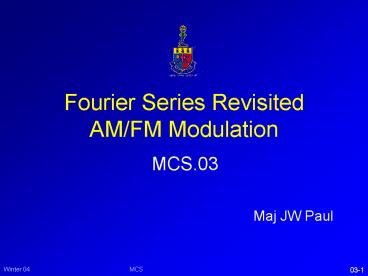Fourier Series Revisited AMFM Modulation PowerPoint PPT Presentation
1 / 40
Title: Fourier Series Revisited AMFM Modulation
1
Fourier Series RevisitedAM/FM Modulation
MCS.03
Maj JW Paul
2
Nothing is ever a total failure
It can always serve as a bad
example.
3
Review
4
How to get from here to there
Sky Wave HF
Tropospheric Wave
MF Direct Wave
Surface Wave LF
Reflected Wave
5
Review
- What is the difference between Phase
delay Time delay
- What can you use this for?
6
Power Loss
- What does this formula tell us?
2
ö
æ
l
ç
G
G
P
P
ç
r
t
t
r
p
4
R
ø
è
7
Todays Class
- Fourier Series and Transforms
- AM/FM modulation
8
Fourier Series Transforms
9
Periodic Signal
- Any signal that repeats itself with a constant
period - Assume s(t) is our function
s(tT) s(t) for any value of t - Period
T
10
Fourier Series
- Any periodic signal can be written as the sum of
harmonics
s(t) a0 ? ancos(2 ? n f t) bnsin(2?n f t)
a0DC or average value.
11
Periodic Signals
12
Even and Odd functions
sin function odd
cos function even
0
sin ( t ? ) cos (t) when ? ?/2 ? ?
phase shift
13
Ringing
14
Linear systems
vin(t) Acos(?t?) vout(t) Bcos(?t?)
Amplitude A, B Phase ?, ?
- Gives a nice harmonic signal
- Non-linear systems are bad !!!
- May not be a correlation between input and output
(feedback screech)
15
Non-Harmonic Signals
- Express input signal as a sum of harmonics (which
are know) - The output is the sum of the responses.
vin(t) A0 A1cos(?1t?1) A2cos(?2t?2)
vout(t) B0 B1cos(?1t?1) Bcos(?2t?2)
16
Non-Periodic Signals
- Consider a non-periodic signal as a periodic
signal with an infinite period - T ?
- now ? is replaced with ?
- result is a Fourier Transform
17
Fourier Transform Pairs
S(?) gives the spectrum of the signal s(t).
18
Why Fourier Series/Transforms
s(t) a0 ? ancos(2 ? n f t) bnsin(2?n f t)
- Mathematically, it is much easier to manipulate
the signal in Fourier space - filtering, phase shifting, frequency analysis...
t
Aside - needs FFT
f
19
Some examples
An interactive overview
http//www.csupomona.edu/apfelzer/demos/toc.html
fourierseries
Intro to Fourier Series (images)
http//cns-alumni.bu.edu/slehar/fourier/fourier.h
tml
20
- If a signal is condensed in time, it will be
expanded in frequency, - inversely if a signal is expanded in time it will
be condensed in frequency. - This means that narrow pulse have large
bandwidths and wide pulse have narrow bandwidths
21
Questions?
22
Experience is something you get just after you
needed it...
23
Modulation Techniques
24
Definition
- Modulation
- process by which some characteristics of a
carrier (sinusoidal wave) is varied in accordance
with a modulating wave (data or analog message) - can change amplitude, phase or frequency of
carrier or combination according to the message
25
Why Modulate a signal?
- An EM signal can easily be generated at voice
frequencies (speaker, telephone, morse code) - But to radiate the signal in free space, antenna
size becomes limiting factor - For a voice signal with a freq of 3 kHz
- ? c/f 1 x 105 m 100 km
26
Amplitude Modulation
- Not superposition
- multiplication
- look at frequency domain...
27
This slide left blank
If you can read this you have a great LCD
projector
28
Frequency Domain Representation of AM Signals
29
AM Fourier Transform
- sAM(t) m(t) cos (2?fct) A cos (2?fct)
- SAM(f) 1/2 M(f-fc) M(ffc) A/2 ? (f-fc)
? (ffc)
Note - need to add base amplitude
30
Other types of AM
- DSB-SC (double side band - suppressed carrier)
- SSB (single side band)
31
Why change a good thing?
BW
fc
f
Original Signal
Carrier Signal
Needs tons o power
fc
fc f
fc - f
2 x BW
Needs twice as much bandwidth
32
DSB-SC and SSB
33
(No Transcript)
34
Pros Cons
- DSB-SC
- requires a local carrier with the same phase and
frequency as the incoming carrier - needs way less energy (50)
- SSB
- as above - but susceptible to noise
- and uses 1/2 the bandwidth
- recreation of complete signal technically complex
35
Frequency Modulation
- Modulation
- process by which some characteristics of a
carrier (sinusoidal wave) is varied in accordance
with a modulating wave (data or analog message) - AM modifies amplitude
- FM modifies frequency
36
FM
37
FM Bandwidth
- If FM carrier frequency is modulated directly by
the data signal, then require 2 x BW - However, can modulate the input signal
- modulation index
- In narrow band FM, can use as little as 30kHz
38
Advantages of FM
- Generally better noise immunity
- noise tends to be an amplitude effect
- FM is based on frequency
- Needs bigger bandwidth - but can use it more
effectively
39
AM vs FM (and PM)
40
Questions?

